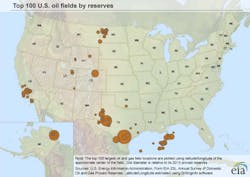EIA: Eagle Ford’s Eagleville oil field largest in US
The Eagleville oil field in South Texas, discovered only in 2009, is the largest in the US, according to a supplement to a report from the US Energy Information Administration called “US Crude Oil and Natural Gas Proved Reserves, 2013.”
EIA respectively ranked the top 100 oil and gas fields in the US based on estimated 2013 proved reserves. Actual proved reserves numbers by field, however, were not disclosed. The agency's last top 100 rankings covered 2009 estimated proved reserves.
Eagleville spans 14 counties and boasted 238 million bbl in production during 2013. It and Briscoe Ranch represent two new additions from the Eagle Ford to both the top 10 and top 100 US oil fields.
Prudhoe Bay in Alaska, the largest US oil field in 2009, fell to third place, also behind the Spraberry trend area of Texas. Rounding out the top 10 oil fields are Wattenberg in Colorado, Briscoe Ranch, Kuparuk River in Arkansas, Thunder Horse in the Gulf of Mexico, Wasson in Texas, Belridge South in California, and Atlantic in the Gulf of Mexico.
The US overall in 2013 had 36.5 billion bbl of crude oil and lease condensate proved reserves, up from 22.3 billion bbl in 2009. The top 100 US oil fields represented 56.4% of the 2013 total and 62.3% of the 2009 total.
The Marcellus area, meanwhile, discovered only in 2008, ascended to the top spot among the top 100 US natural gas fields, surpassing the Barnett in Texas. The Marcellus, which produced 2.8 tcf in 2013, encompasses proved reserves from north-central West Virginia and the southwest corner to the northeast of Pennsylvania.
Rounding out the top 10 gas fields are the Fayetteville in Arkansas, San Juan basin in Colorado and New Mexico, Haynesville in Louisiana, Pinedale in Wyoming, Carthage in Texas, Jonah in Wyoming, Wattenberg, and Prudhoe Bay.
The US overall in 2013 had 354 tcf of total proved gas reserves, up from 283.9 tcf in 2009. Top 100 US gas fields represented 67.7% of the 2013 total and 60.8% of the 2009 total.
EIA notes that it defines a field as “an area consisting of a single reservoir or multiple reservoirs all grouped on, or related to, the same individual geological structural feature and/or stratigraphic condition.” It added, “There may be two or more reservoirs in a field that are separated vertically by intervening impervious strata or laterally by local geologic barriers, or by both.”



